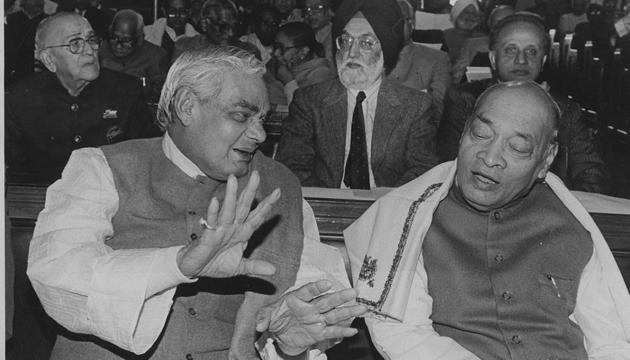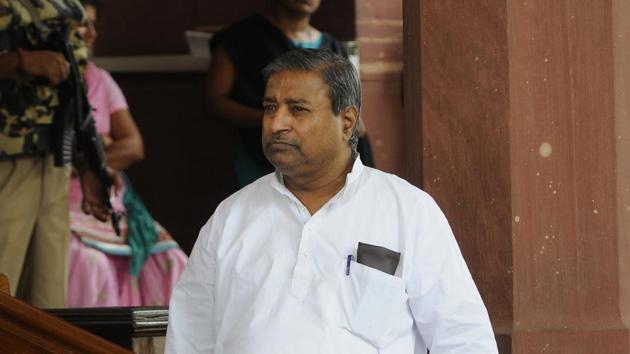Yet, there are politicians whose role at the time of the Babri Masjid demolition and the Ram temple movement caused a series of events to unfold — from Kalyan Singh and Lal Krishna Advani to Vinay Katiyar, Murli Manohar Joshi and Mahant Avaidyanath of the Gorakhnath Math. Where are they now? Some have passed away, some have grown old and some are ailing or living in their twilight years.

Now weak and ailing, the “temple hero” — as he was called — sounded emotional.
The three domes collapsed along with my government, he said. “I was given a day-long imprisonment. I spent those 24 hours in Tihar jail happily.”
“The 500-year-long struggle to reclaim the Ram Janmabhoomi is finally over,” he said. Born in 1932, Singh was a member of the Rashtriya Swayamsevak Sangh (RSS). He returned to power in 1997 but fell out of favour with the leadership in the late 1990s. He quit the party after he was unceremoniously removed from the chief minister’s post in 1999. He floated the Rashtriya Kranti Party and contested the 2002 assembly elections. His fledgling party polled about 3 percent votes and won four seats.
The 10-time assembly election winner and two-time MP returned to the BJP in 2004. He quit again in 2009 and again floated the Jan Kranti Party in 2010, briefly joining hands with the Samajwadi Party of Mulayam Singh Yadav. In 2014, he merged his JKP with BJP and was appointed Governor of Rajasthan that year. His political career ended with the governorship of Rajasthan in September 2019. Singh passed away on August 21, 2021, aged 89. He was awarded the Padma Bhushan posthumously.

It was noon on December 6, 1992, when kar sevaks who had congregated in the Ayodhya began attacking the domes of the mosque. The then Prime Minister PV Narasimha Rao, of the Congress party, remained in limbo.
There are many conjectures about his inaction but the question that was on everyone’s mind was whether he colluded with the BJP over the demolition. When asked about it by journalists, he replied cryptically, “I am a politician.” Many believe that Rao wanted a solution to the raging dispute but he eventually miscalculated, misjudged and mishandled the situation.
“The Babri Masjid could have been saved if there was political will to act. The then Prime Minister PV Narasimha Rao did not accept a comprehensive contingency plan of the home ministry prepared before the demolition,” Madhav Godbole claimed in his book, The Babri Masjid-Ram Mandir Dilemma: An Acid Test for India’s Constitution. Godbole was the Union home secretary at the time.
Rao’s tenure ended in 1996 accompanied by a steep decline in Congress’ numbers in the Parliament, and the BJP emerged as the single largest party. While the Congress won 140 seats, the BJP received their highest tally till then — 161. The Muslims deserted the Congress as it failed to protect their shrine.
Sonia Gandhi, who had been reluctant to enter politics after the assassination of her husband and late Prime Minister Rajiv Gandhi in 1991, finally took the plunge in 1997 and with that Rao’s era ended. He died in December 2004.
The troika of Vajpayee, Advani and Joshi
The famous triumvirate of the 1990s — Atal Bihari Vajpayee, Lal Krishna Advani and Murli Manohar Joshi — had different roles assigned to them by the all-powerful RSS.
Advani became the poster boy of the temple movement and Hindutva; Joshi remained a central figure; Vajpayee stayed away and disapproved of the demolition.
One of the founders of the BJP in 1980, Advani headed the party thrice from 1986-1990, 1993-1998 and 2004-2005. However, his yatra from Somnath to Ayodhya in the 1990s turned the country’s mood in favour of the Sangh Parivar’s campaign to establish a temple in what they considered to be the birthplace of Ram (Ayodhya). As mentioned above, it also helped a great deal with the party’s political fortunes. When Bihar chief minister Lalu Prasad Yadav disallowed his yatra from passing through the state, the kar sevaks were infuriated. Two years later, as the 16th-century structure was being brought down, Advani watched from a makeshift dais, looking a bit disturbed. He spoke constantly to then chief minister Kalyan Singh who was monitoring the situation from his office in Lucknow. Forty-nine FIRs were lodged against unidentified kar sevaks and eight BJP-VHP leaders, including Advani and Joshi.
It was only 28 years later, on September 30, 2020, that a special CBI court finally acquitted Advani and 31 others, including Singh, Uma Bharti, and Joshi in the Babri demolition case for lack of evidence. Ruling out a conspiracy, the court described the demolition as a spontaneous and not a pre-planned act.
In November 2019, the Supreme Court had already announced its verdict in favour of the Ram temple being built on the site.
Advani’s political career grew as his party won 121 seats in the Lok Sabha in 1992 (from 2 in 1984) and 161 in 1996. Advani became Union home minister from 1998-2004 and was elevated to deputy prime minister in Vajpayee’s government in 2002. When the party lost the elections, Advani became the leader of the opposition in the Lok Sabha.
Advani’s relations with the RSS suffered a blow after the Sangh leadership suggested that he and Vajpayee make way for new leaders. He stepped down from the party presidency in 2005. However, he was announced as the party’s prime ministerial face in the 2009 general elections, which went in favour of the Congress.
In his 90s now, he is not in active politics and is unlikely to attend the consecration ceremony in person.
Vajpayee became the prime minister thrice — for 13 days in 1996 (then President Shanker Dayal Sharma invited the BJP, the single largest party in the Lok Sabha at the time, to form the government, but it failed to muster support of other parties); for 13 months in 1998 (the government toppled after AIADMK leader Jayalalithaa withdrew support); and finally, in 1999 for a full term. Vajpayee was the liberal face of the party and as Lucknow MP, he had the support of Muslims. Some BJP leaders claim that he disagreed about mixing politics with religion and described the day the Masjid was demolished as “unfortunate.” Vajpayee died in 2018 at the age of 94.
Joshi taught physics at Allahabad University before he joined politics. A member of the BJP think tank, he was actively involved in the planning of the temple movement and was present on the dais on December 6. His beaming picture with Uma Bharti when the kar sevaks were pulling down the domes generated controversy. He went on to become the Union human resources development minister from 1999 to 2004 and was last elected to the Lok Sabha in 2014. Now, aged 90, he is retired from politics. Bharti, the first politician in a saffron robe to become CM of any state — Madhya Pradesh — was famous for her fiery speeches. However, in later years, she had strong differences with the BJP leadership over the selection of Shivraj Singh Chauhan. She quit the party, floated her own, and rejoined the party but moved out of MP to UP. She is no longer active in politics.

Brought up in Ayodhya, Vinay Katiyar was the founder and president of Bajrang Dal in 1984. It later became the youth wing of the VHP, often triggering controversies with his provocative statements.
It was the VHP which not only led the movement starting in 1984 but also mobilised Hindu saints from across the country. It participated in all talks to resolve the temple/mosque issue. And though Somnath to Ayodhya yatra of Lal Krishna Advani whipped up passions across the country, it was the VHP leadership who managed kar sevaks, including on demolition day in 1992. Katiyar, who openly claimed a role in the demolition was not only a rabble-rouser but also one of the managers of the movement at the local level.
In 2002, he became the BJP state president of UP and the party’s national general secretary in 2006. He was elected to the Parliament twice from Faizabad (now Ayodhya) Lok Sabha constituency. He was one of the 31 accused in the Babri Masjid demolition case. In 2012, he was elected to the Rajya Sabha, where he remained a member till 2018.

From the first meeting of the Hindu Jagran Manch in 1983, the then VHP general secretary Ashok Singhal’s contribution to the temple movement is immense. He was everywhere planning and executing hundreds of programmes. As in charge of the Ram temple movement, he interacted with media, local saints, states and Central government, district administration, archaeological experts and lawyers, besides planning and executing various programmes.
He organised an indefinite fast during late prime minister Atal Bihari Vajpayee’s tenure to apply pressure on the National Democratic Alliance (NDA) government to pave the way for the construction of the temple. Till his death in 2015, he did not give up despite his deteriorating relations with the BJP leadership.

VP Singh was the prime minister between 1989 and 1990 when the temple movement was on the rise. Advani had embarked on his Somnath-Ayodhya yatra and the then chief minister of Uttar Pradesh, Mulayam Singh Yadav, was all geared up to stop it on the state borders. At the behest of VP Singh, who did not want Mulayam to take credit for stopping the yatra and further consolidate his electoral influence on the Muslims, Lalu Yadav, the then CM of Bihar, stopped the Rath Yatra in Samastipur after it entered Bihar.
Lalu became a hero, but it did not impact his political career as much as the fodder scam which took place when he was CM, and for which he was convicted and jailed.
Mulayam missed the bus but grew in political stature. He floated his own party in 1992 and thereafter dictated state politics. Even when he was out, he was not down. He apologised for police firing on kar sevaks in 1990 saying he did so to protect the country and the Constitution. As many as 16 kar sevaks marching towards the disputed shrine died in police firing after they failed to obey the orders of the police to stop.
Mulayam missed the bus but grew in political stature. He died in 2022.
Pre-history
The three heads of Gorakhnath Peeth to which the current Uttar Pradesh CM belongs, located 140 km from Ayodhya, played a pivotal role in the temple movement during colonial times. The head priest, Digvijayath, mobilised Hindus in favour of a temple starting in 1935 — in December 1949, a Ram idol was placed in the mosque, following which the shrine, already a site of dispute, was locked under the orders of the then district magistrate KK Nayar. Nath died in 1969.
In 1986, when the district magistrate ordered the opening of the lock following the order of a sessions judge, Avaidynath was the head of the peeth.
Digvijaynath formed the Akhil Bharatiya Ram Rajya Party, while Avaidyanath who had been winning assembly elections since 1962, floated the Ram Janmabhoomi Mukti Yagya Samiti to bring all Hindu organisations and sadhus under one banner. In fact, it was he who organised a yatra from Sitamarhi in Bihar (considered to be the birthplace of Sita) to Ayodhya in 1984 where the call to “liberate” Ram Janmabhoomi was first made in contemporary politics. He raised the demand for unlocking the disputed shrine in 1985. Mahant Ramchandra Paramhans of Digamber akhara was also a key figure in this movement.
UP chief minister Yogi Adityanath first visited Gorakhpur in 1992 inspired by the temple movement. Impressed with his capabilities, Mahant Avaidyanath appointed him his successor in 1996. After his death in 2014, Adityanath inherited his post in the peeth.
From her perch in Lucknow, HT’s senior journalist Sunita Aron highlights important issues related to Uttar Pradesh















